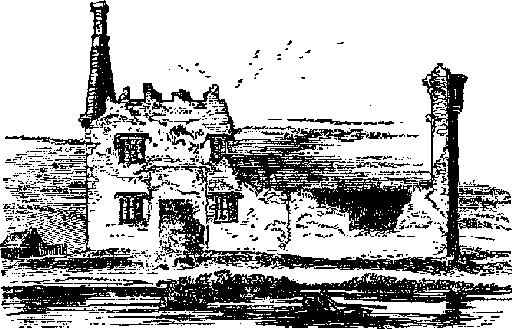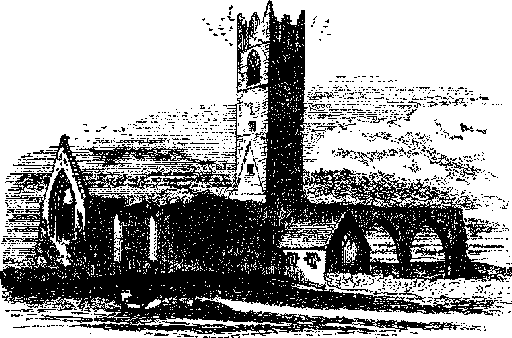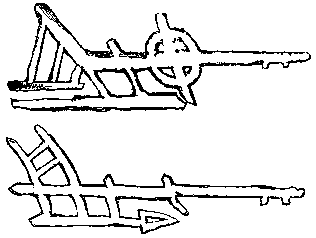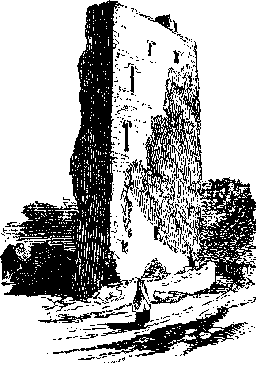

WE ARE AFLOAT ON THE RIVER Gaillimh, with our starboard alongside Tír Oileáin, (probably "The Holm land")--the runied castellated mansion, figured in the headpiece, seventy-five feet long by twenty-five feet broad, and said by tradition to have been one of the earliest locations of the Earls of Clanricarde. It possesses little architectural or picturesque interest, as like most ruins in the neighbourhood of crowded localities, every accessible quoin or dressed stone has been removed, and no fostering ivy has as yet thrown a green mantle over its bare gray walls.
Numerous are the legends still repeated of the prowess of the De Burgos, and the wiles and daring of the O Flaherties, in connexion with this castle, erected to defend the river's ford at this point. It is frequently alluded to in the "Annals of the Four Masters," and in other authentic histories, and so late as 1641 it was garrisoned by Diarmuid Ó Dálaigh.
Where the earliest Castle of Gaillimh absolutely stood, unless at this spot, it is now difficult to determine. Tuirgéis, the sanguinary Danish commander, overran Connacht in 835, and "the ancient town of Galway was destroyed." Hardiman says, the Castle Dún bun na Gaillimhe, or the fortification at the mouth of the Galway river, was erected soon after the defeat of the Danes at Clontarf; and then its erection, and the improvement of the town, were a source of jealousy to the people of Munster, between whom and those of Connacht there had long existed a considerable degree of competition. Conor, King of Munster, in 1132 despatched a body of troops by sea, commanded by Cormac Mac Carthaigh, who besieged and took the Castle. Again, in 1149, Turloch O Briain, King of Munster, invaded Connacht, and destroyed the town and Castle of Gaillimh, which ravages, however, appear to have been soon repaired. In 1230 Hugh O Flaherty, chief of his name, fortified himself in the Castle of Gaillimh, which, by his spirited resistance, he was able to keep against De Burgo.
Passing up the river by Jordan's Island, we steam past Mionloch Castle, the picturesque residence of Sir Thomas Blake, Bart.[fn14-1] Neither the family records, nor any of the published histories, afford a clue to the date of its erection; but the Mionloch family founded one of the tribes of Galway, and are connected with, if not descended from the English Blakes of Cumberland.
So far on our course we have passed through the barony as well as the county of Galway--between the parishes of Rahún on the left and St. Nicholas on the right; and in the latter, besides that of Tír Oileáin, already described, we have the ruins of Caisleán Gearr, Baile Briota and Merlin Castles; but they are not of sufficient importance nor vicinity to the lake to merit detailed description, or require illustration.
The large parish of Órán Mór, through a portion of which we passed on approaching Galway, and which contains the castle and townland of Mionloch, here runs down to the lake margin between those of St. Nicholas and Claregalway; but its early inhabitants seem to have concentrated their energies more upon its sea-board than its lacustrine border, and have left us nothing worthy of attention at this end of it, except the ruins of the square Castle of Cluain a' Cháinín and that of Ceathrú Bhrúna.
Here, as we pass upwards, the Coirib River diverges to the west; and, we enter, through a deep sedgy marsh or bog, about a mile in length, the canal traditionally called the "Friars' Cut," and emerge into the broad waters of the Lower Lake. On the left, or western side of our course, may be seen the ridge of hills that stretches from Gaillimh to Uachtar Ard; and along their slopes the demesnes of Woodstock, Farm, Danesfield; and also the village of Magh Cuilinn, as we proceed, the woods of Druim Cunga, Cnoc Bán, and Ros.
As we pass into the broad uninterrupted space of lower lake, we have on our right the marble quarries Angliham, and soon get a glimpse over the low limestone plain, eastward of our course, of the butt of the old castle, and the tall slender tower that rises from the centre of the Friary or cruciform church of Baile Chláir na Gaillimhe, Claregalway, which, although at some distance from the water's edge, is not without our prescribed parochial limits, and is of too great beauty and importance to be omitted; and, moreover, it is on the highroad between Galway and Cong, being but six miles distance from the former. A more picturesque group of ruins, or one comprising a greater variety for the display of the artist's pencil, can scarcely be found, even amidst the multitudinous remains that crowd the parishes abutting upon Loch Coirib, than this scene presented in former days--with its little mill, and slow winding river passing under a long, low, many-arched bridge, but which is now replaced by a canal, and a single formal arch.
The massive square ivy-clad keep of the castle, now used as a barn, stands on the east of the roadside, and was formerly the residence of Mac Uilliam Uachtar De Burgo, as stated by the Four Masters, under the date 1469, in which year it was burned by Aodh Rua O Domhnaill. As it was contiguous to the famous battlefield of Cnoc na dTuagh, fought between the Earls of Kildare and Clanricarde in I504, it was occupied by the Irish party; and in 1512 it was again the seat of war. It is at present sixty-two feet high, twenty long, and twenty broad, and partakes of the general characteristics of such buildings in the West--consisting of a pointed-arched entrance to the porch, within which is the usual Poll-na-morrough or "murdering hole," an aperture in the thick vaulted roof above, through which missiles could be showered on assailants who had gained an entrance through the outer door. A winding stone staircase leads from story to story, the lower one of which was usually stone-arched, and over it an upper apartment with a large handsome chimneypiece, and illuminated by mullioned or decorated narrow lights; and as here, a corbeled projection all round for supporting a wooden floor, or sometimes a stone arched one; and above that the parapet, either plain or corbeled, and having one or more turrets at the angles; while the prison, garderobe, and some secret hiding holes, were usually placed in the thickness of the northern wall. In addition, this castle had a portcullis, the groove of which shows long and constant usage.
The records state that about the year 1290, John De Cogan built a Monastery at Clare-yn-dowl for Franciscan Friars, in a very elegant style, and at great expense.
Although the modern name of this parish is Clare-Galway, it is called in Irish Baile an Cháir, the town of the flat. There are several Clares and Bally-Clares in Connacht; but this locality is styled, in ancient documents "Clár an Diabhail," or "Devil's Flat," or board, because, according to tradition, the rapid river at this place was formerly crossed on planks supported on pillars.
The ruins of the Friary or Convent Church stand on the right or northern bank of the river, a little below the Castle; and, like most other structures which came from the hands of the Franciscans, it is characterized by a taste and elegance which neither time, nor the rough hand of the despoiler has been able to efface. It was originally cruciform; and from the intersection of the nave, choir, and transepts, was reared, on high pointed arches, a tall slender tower.
The illustration has been taken from the south-east, and represents, besides the tower, the dilapidated east window, the northern arches of the nave, and the small chapel, in which the friars had service up to 1860. The entire length of this church was one hundred and forty-two feet, and that of the transept, one hundred and twelve.

The height of the tower is about eighty feet. Among the references made to this place by our annalists and ecclesiologists, it is said, under the date of 1296, that Philip de Blund, Archdeacon of Tuam, during the time of the dispute respecting the episcopacy of Enachdun, took by violence from the friars of Clare-Galway, in which place they had been deposited, the pontificalia, consisting of the chest containing the " episcopal mitre, together with the pastoral staff, and sundry other things," of the neighbouring cathedral.
There are not now many tombs of note within the precincts of this
venerable and still beautiful pile; but among the well-cut flagstones
paving the aisles of nave and transept, may be seen early indications
of the agricultural skill of the people of this great fertile plain or
Clár, in the number and variety of ploughs carved
 upon them. They bear date from the middle of the seventeenth to the end
of the eighteenth centuries; and the two preceding fac-simile cuts,
selected out of eight represent that early civilizer as it existed in
Galway, the upper one in 1696, and the lower in 1773.
Upon the left or southern bank of the river stands a large
ecclesiastical ruin, surrounded by a graveyard.
upon them. They bear date from the middle of the seventeenth to the end
of the eighteenth centuries; and the two preceding fac-simile cuts,
selected out of eight represent that early civilizer as it existed in
Galway, the upper one in 1696, and the lower in 1773.
Upon the left or southern bank of the river stands a large
ecclesiastical ruin, surrounded by a graveyard.
About eight miles from the City of the Tribes, and behind, and somewhat to the north-east of Baile Chláir na Gaillimhe, rises a sloping green elevation which is known as Knocktoe, or Cnoc na dTuagh, " the hill of the hatchets " or battle-axes, scene of a slaughter of the De Burgos and their Irish allies by the Normans of Leinster led by the Lord Deputy Gerald, eighth Earl of Kildare.
Passing along the road from Baile Chláir na Gaillimhe by Leacht-George, and northwards towards Áth Chinn, we cross an angle of Leacach parish. Upon the left of the road stands a very fine lios or earthen fort; and on the right are the young woods of Badhún Mór. We then proceed by Creag Castle, one of the few old castellated mansions still inhabited in Connacht. It was erected by Patrick Kirwan in 1648, and stands in a spacious well-wooded demesne, and was the birth-place and formerly the residence of the distinguished philosopher, and President of the Royal Irish Academy. Within Creag demesne, there is a small ruined church, and to the south-west is seen the tower of Lios Chananáin Castle, and more to the west stands Druim Grifín held by Uileóg Riabhach in 1686.
Outside the north side of the demesne is a pretty bit or landscape, and a " flash " of water called Áth cloigín, or the " ford of the little bell; " and beyond it the mills of Creag, near which the tourist, if travelling by the road, can turn down to the lake-side by Winterfield, and approach the group of ruins which stands beside the landing place of Annaghdown.
 On the west, as the eye traverses this apparently sterile region, it
rests on the chimney of the lead mine at Gort Mór, and the grey
side-wall of Tulach Cadhain Castle popularly called Caisleán na
Caillighe, or the Hag's Castle of which the accompanying illustration,
from a drawing made by Mr. Wakeman gives a good idea. This castle is
called Tullokyne on the Ordnance Map, and it must not be confounded
with Caisleán na Caillighe on Loch Measca, referred to in the Donegal
Annals under A.D. 1195. In 1586, Muriertach O Conor held the castle of
Tullekyhan. Of its origin, or true history, we know nothing but it is
mentioned by O Flaherty in 1684, when a similar
structure, a few paces distant, existed, which was blown down by the
great storm of January, 1839. They were called, says Hardiman, "the
Castles of the two Sisters, of whom some romantic tales of former days
are still current."Among these, the people state that when these old maids
were too old to visit, they built these castles in such close contiguity
in order that they might daily "barge" one another from their
respective windows. At long run, however, the dame that owned the present
ruin cut short the dispute by killing her sister!
On the west, as the eye traverses this apparently sterile region, it
rests on the chimney of the lead mine at Gort Mór, and the grey
side-wall of Tulach Cadhain Castle popularly called Caisleán na
Caillighe, or the Hag's Castle of which the accompanying illustration,
from a drawing made by Mr. Wakeman gives a good idea. This castle is
called Tullokyne on the Ordnance Map, and it must not be confounded
with Caisleán na Caillighe on Loch Measca, referred to in the Donegal
Annals under A.D. 1195. In 1586, Muriertach O Conor held the castle of
Tullekyhan. Of its origin, or true history, we know nothing but it is
mentioned by O Flaherty in 1684, when a similar
structure, a few paces distant, existed, which was blown down by the
great storm of January, 1839. They were called, says Hardiman, "the
Castles of the two Sisters, of whom some romantic tales of former days
are still current."Among these, the people state that when these old maids
were too old to visit, they built these castles in such close contiguity
in order that they might daily "barge" one another from their
respective windows. At long run, however, the dame that owned the present
ruin cut short the dispute by killing her sister!